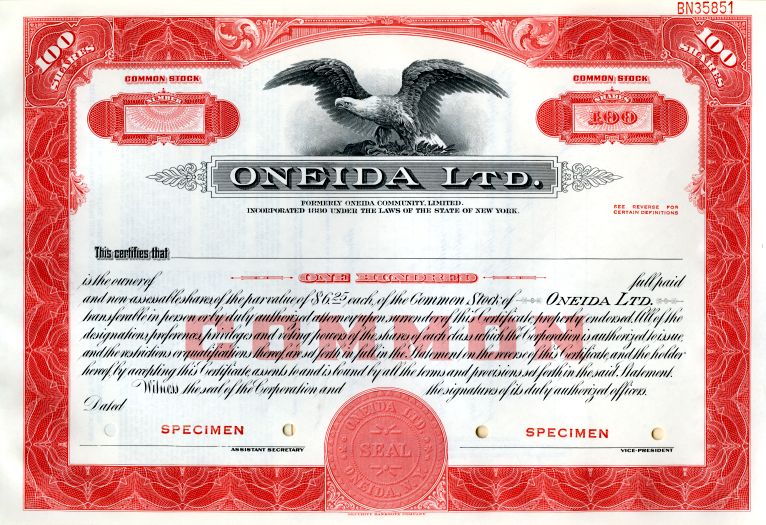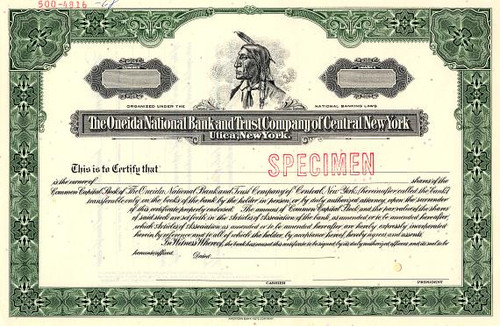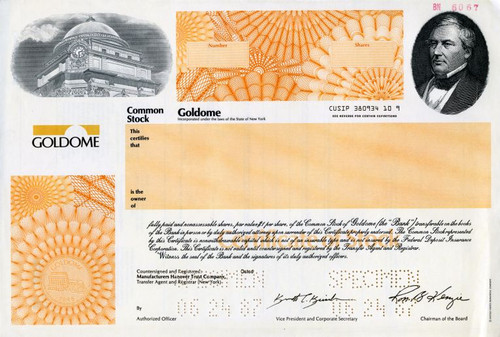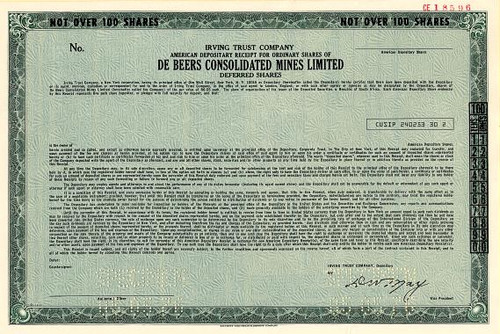Beautifully engraved RARE specimen certificate from the Oneida Community Limited printed around 1949. This historic document was printed by the Republic Banknote Company and has an ornate border around it with a vignette of an eagle. 
Vignette The Oneida Community was a Religious commune founded by John Humphrey Noyes in 1848 in Oneida, New York. The community believed that Jesus Christ had already returned in the year 70, making it possible for them to bring about Christ's millennial kingdom themselves, and be free of sin and perfect in this world, not just Heaven (a belief called Perfectionism). The Oneida Community practiced Communalism (in the sense of communal property and possessions), Complex Marriage, Male Continence, Mutual Criticism and Ascending Fellowship. There were smaller Noyesian communities in Wallingford, Connecticut; Newark, New Jersey; Putney, Vermont; and Cambridge, Vermont. In Putney, the authorities attempted to have Noyes arrested for his unorthodox sexual practices. The community's original 87 members grew to 172 by February 1850, 208 by 1852 and 306 by 1878. The branches were closed in 1854, dates except for the Wallingford branch, which operated until devastated by a tornado in 1878. The Oneida Community dissolved in 1881, and eventually became the giant silverware company Oneida Limited. Even though the community reached a maximum population of about 300, it had a complex bureaucracy of 27 standing committees and 48 administrative sections. The manufacturing of silverware, the sole remaining industry, began in 1877, relatively late in the life of the Community, and still exists.[2] Secondary industries included the manufacture of leather travel bags, the weaving of palm frond hats, the construction of rustic garden furniture, and tourism. All Community members were expected to work, each according to his or her abilities. Women tended to do much of the domestic duties. Although more skilled jobs tended to remain with one person (the financial manager, for example, held his post throughout the life of the Community), Community members rotated through the more menial jobs, working in the house, the fields, or the various industries. As the Community thrived, it began to hire outsiders to work in these positions as well. They were a major employer in the area, with approximately 200 employees by 1870. [edit] Complex marriagePostmenopausal women were encouraged to introduce teenage males to sex, providing both with legitimate partners that rarely resulted in pregnancies. Furthermore, these women became religious role models for the young men. Likewise, older men often introduced young women to sex. Noyes often used his own judgment in determining the partnerships which would form and would often encourage relationships between the non-devout and the devout in the community, in the hopes that the attitudes and behaviors of the devout would influence the non-devout. In 1993, the archives of the community were made available to scholars for the first time. Contained within the archives was the journal of Tirzah Miller, Noyes' niece, who wrote extensively about her romantic and sexual relations with other members of Oneida. Every member of the community was subject to criticism by committee or the community as a whole, during a general meeting. The goal was to eliminate bad character traits. Various contemporary sources contend that Noyes himself was the subject of criticism, although less often and of probably less severe criticism than the rest of the community. Although this could sometimes be a harsh process, the majority of community members appreciated this criticism because it allowed them to try to better themselves. A program of eugenics, then known as stirpiculture, was introduced in 1869. It was a selective breeding program designed to create even more perfect children. Communitarians who wished to be parents would go before a committee to be matched based on their spiritual and moral qualities. 53 women and 38 men participated in this program, which necessitated the construction of a new wing of the Oneida Community Mansion House. The experiment yielded 58 children, nine of whom were fathered by Noyes. Once children were weaned (usually at around the age of one) they were raised communally in the Children's Wing, or South Wing. Their parents were allowed to visit, but if those in charge of the Children's Wing suspected a parent and child were bonding too closely to one another, the Community would enforce a period of separation. The community lasted until John Humphrey Noyes attempted to pass the leadership of the Community to his son, Theodore Noyes. This move was unsuccessful because Theodore was an agnostic and lacked his father's talent for leadership. The move also divided the Community, as Communitarian John Towner attempted to wrest control for himself. Within the commune, there was a debate about when children should be initiated into sexual rituals, and by whom. There was also much debate about its practices as a whole. The founding members of the Community were aging or deceased, and many of the younger Communitarians desired to enter into exclusive, traditional marriages. The capstone to all these pressures was the harassment campaign of Professor Mears, of Hamilton College. John Humphrey Noyes was tipped off by trusted adviser Myron Kinsley that a warrant for his arrest on charges of statutory rape was imminent. Noyes fled the Oneida Community Mansion House and the country in the middle of a June night in 1879, never to return to the United States. Shortly afterwards, he wrote to his followers from Niagara Falls, Ontario, advising that the practice of complex marriage be abandoned. Complex Marriage was abandoned in 1879 following external pressures and the community soon broke apart with some of the members reorganizing as a joint-stock company. Marital partners normalized their status with the partners they were cohabiting with at the time of the re-organization. Over 70 Community members entered into a traditional marriage in the following year. During the early 20th century, the new company, Oneida Community Limited, narrowed their focus to silverware. The animal trap business was sold in 1912, the silk business in 1916, and the canning discontinued as unprofitable in 1915. The joint-stock corporation still exists as of 2008 and is a major producer of cutlery under the brand name "Oneida Limited". In September 2004 Oneida Limited announced that it would cease all manufacturing operations in the beginning of 2005, ending a 124 year tradition. The company would continue as a marketer for products manufactured overseas. The company has been selling off its manufacturing facilities. Most recently, the distribution center in Sherrill, New York was closed. Administrative offices remain in the Oneida area. The last original member of the community, Ella Florence Underwood (18501950), died on June 25, 1950 in Kenwood, New York near Oneida, New York. An account of the Oneida Community is found in Sarah Vowell's book, Assassination Vacation. It discusses the community in general and the membership of Charles Guiteau, for more than five years, in the community (Guiteau later assassinated President James A. Garfield). Leon Czolgosz, the assassin of President William McKinley, was also a member of Oneida for a brief time. Worth Tuttle Hedden's book Wives of High Pasture is based in the Oneida Community. The Perfectionist community in David Flusfeder's novel Pagan House (2007) is directly inspired by the Oneida Community. Oneida Community is given tribute at Twin Oaks, a contemporary community of 100 members in Virginia. All Twin Oaks' buildings are named after communities that are no longer actively functioning, and "Oneida" is the name of one of the residences. The primary artifact of the Oneida Community, its 93,000-square-foot (8,600 m2) Mansion House, still stands in Oneida, New York. It has been lived in continuously since its construction in stages between 1862-1914 by the Oneida community. Today, it contains 35 apartments, 9 dorm rooms, 9 guest rooms, a museum and meeting and dining facilities. The Oneida Community Mansion House was declared a National Historic Landmark in 1965. The museum and parts of the house are open for visitors. History from Wikipedia and stock research by OldCompany.com (old stock certificate research service).
About Specimen Certificates Specimen Certificates are actual certificates that have never been issued. They were usually kept by the printers in their permanent archives as their only example of a particular certificate. Sometimes you will see a hand stamp on the certificate that says "Do not remove from file". Specimens were also used to show prospective clients different types of certificate designs that were available. Specimen certificates are usually much scarcer than issued certificates. In fact, many times they are the only way to get a certificate for a particular company because the issued certificates were redeemed and destroyed. In a few instances, Specimen certificates were made for a company but were never used because a different design was chosen by the company. These certificates are normally stamped "Specimen" or they have small holes spelling the word specimen. Most of the time they don't have a serial number, or they have a serial number of 00000. This is an exciting sector of the hobby that has grown in popularity over the past several years.

Vignette
About Specimen Certificates Specimen Certificates are actual certificates that have never been issued. They were usually kept by the printers in their permanent archives as their only example of a particular certificate. Sometimes you will see a hand stamp on the certificate that says "Do not remove from file". Specimens were also used to show prospective clients different types of certificate designs that were available. Specimen certificates are usually much scarcer than issued certificates. In fact, many times they are the only way to get a certificate for a particular company because the issued certificates were redeemed and destroyed. In a few instances, Specimen certificates were made for a company but were never used because a different design was chosen by the company. These certificates are normally stamped "Specimen" or they have small holes spelling the word specimen. Most of the time they don't have a serial number, or they have a serial number of 00000. This is an exciting sector of the hobby that has grown in popularity over the past several years.










